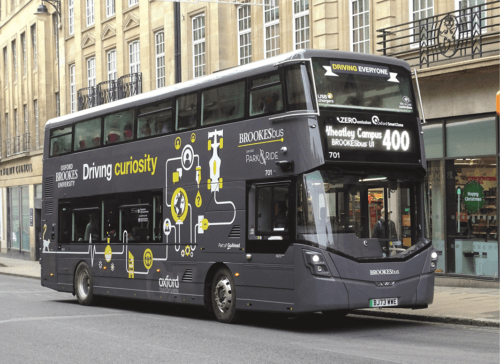
Oxfordshire County Council is using CitySwift technology to monitor its 10% bus productivity target
Following the award of £32.8 million funding by the Department for Transport in March 2022 to Oxfordshire County Council to support a zero carbon transport network in Oxford City’s ‘SmartZone,’ the county council is using the CitySwift platform to monitor progress. As part of the Zero Emission Bus Regional Areas (ZEBRA) scheme, Oxford’s two main bus operators and Oxfordshire County Council also committed significant capital investment in a fleet of 159 new electric buses plus associated charging infrastructure.
Closely monitoring the impact of congestion-easing measures, including a parking levy, new traffic filters and a wider zero-emission zone, plays a crucial role in achieving a return on this investment by improving ‘bus productivity’ by 10%, the council says. “The new bus journey time measures will be implemented by autumn 2024. From there we’ll use CitySwift to continuously monitor performance against 2019 so we can track our progress to the 10% goal,” explained Martin Kraftl, Senior Transport Planner at Oxfordshire County Council.
CitySwift enables stakeholders to monitor the impact of supporting measures on bus productivity to ensure a solid return on the investment. The platform provides data analytics and visualisations of journey times, average bus speeds, network pinch points, service punctuality, and passenger delay minutes.
“The main focus for us is the journey times. But, we’ll also be using the system to look at bus boardings, passenger numbers and other key information. I think we’ve probably only scratched the surface really in terms of the functionality available to us. Once we start getting into the evaluation for the bigger SmartZone area, I think we’ll be reporting against a few different metrics,” added Martin.
The primary intervention for the Central Oxfordshire Travel Plan to achieve the 10% improvement is a traffic filters scheme on key routes across the city which are expected to improve bus services and journey times, reduce walking and cycling accidents and improve air quality across the city.
CitySwift will provide an independent, objective data source to make it possible to transparently monitor bus journey times and optimise the performance of the bus network, giving access to accurate, reliable data to assess progress towards the enhanced partnership commitments of reducing bus journey times by 10%.
”Keeping everything out in the open has been important in terms of setting up a method for measuring bus journey times that everybody is comfortable with. There’s quite a lot at stake in terms of bus company investments in new vehicles and other initiatives so we needed something that we could all put our trust in,” Martin continued. “We’d be sending off emails and asking the operators to put reports together, having to know exactly what information we needed. It was really time consuming for both us and the operators. Whereas now we have the data so easily accessible through the dashboard. It’s a big plus in terms of being able to evaluate quickly, and being able to do the analysis that is most helpful to us. We can interrogate the data in the ways that we want to.
“We’re not going to be getting into discussions about whether the data is right or wrong, or was it collected in the right way. We’ve got a common agreement that is the data source that we’re all using. And that means we can focus on discussing the important, material issues about whether things are working or not working knowing that we can fully trust the data.
“Now when we’re looking at the effect of schemes, for example the new bus lane project, we can go in and perform detailed analysis of the data ourselves in the knowledge that we can corroborate our analysis with the operators and look at it from their side. Most importantly, we’re all looking at the same system and the same data.
“The business case for the investment is based on achieving a 10% saving in terms of bus productivity. CitySwift provides us with the robust monitoring we need to demonstrate our progress towards this target to all stakeholders. We’re measuring 2019 as the base year and we’ll be comparing and combining data across all services operating in the SmartZone on a rolling basis, once the journey time measures come in.”

